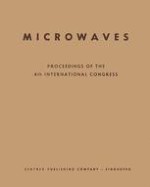1963 | OriginalPaper | Chapter
Broadband detectors for microwave modulated light
Authors : B. J. McMurtry, J. B. Gaenzle, A. E. Siegman
Published in: Microwaves
Publisher: Macmillan Education UK
Included in: Professional Book Archive
Activate our intelligent search to find suitable subject content or patents.
Select sections of text to find matching patents with Artificial Intelligence. powered by
Select sections of text to find additional relevant content using AI-assisted search. powered by
In order to take advantage of the extremely large information rates that are potentially available with optical masers, one must be atrle to modulate light at high modulation frequencies and over very large modulation bandwidths. Conventional photoelectric and photoconductor devices have found wide use aslight demodulators; however their modulation frequencies are generally limited to a few hundred megacycles. In this paper we describe devices which are capable of demodulating light which has been modulated at microwave frequency rates and over microwave modulation bandwidths. Such a device, which we call a microwave phototube [1] -[5], is shown schematically in Fig. 1. It consists of a conventional microwave tube in which the normal thermionic cathode has been replaced by a photocathode. In this case, the microwave-modulated light strikes the cathode producing a microwave-modulated or ‘pre-bunched’ electron beam. This beam then interacts with the microwave tube circuit and the modulation is obtained at the output of the tube. Slow-wave circuits such as the helix used in conventional TWT’s are ideally suited to the larger bandwidths desirable for microwave phototubes. In fact, a number of experiments have been performed using such a traveling-wave microwave phototube [3], [5].
